Carry-On Travel Essentials: Luggage, Electronics, Toiletries, and Clothing
“You do realize you’re very late,” he said.
I was in the Dublin Airport, heading back to Portland, Oregon. I’d shown up ninety minutes before my flight was scheduled to take off — plenty of time, I had assumed, unaware that US Customs was handled on the Dublin side of this flight — and the guy behind the ticket counter advised me that I “may want to run.”
I lugged my duffel up onto my right shoulder, clutched my computer bag to my left side, and started jogging toward security. I was winded almost immediately; I reached the security line panting and miserable.
By the time I got to the US Customs line, I was drenched in sweat, and my right shoulder was on fire from hauling the duffel.

During the agriculture inspection, I heard the final boarding call for my flight. I snatched my bags from the belt and sprinted for the gate, breathlessly waving my boarding pass at the gate agent as she was about to close the boarding door.
I spent the next seven hours feeling my muscles knot up and wondering just how bad I must have smelled.
There’s gotta be a better way to travel, I thought to myself.
Traveling Well Is an Art
My experience in Dublin helped me realize I was making a lot of mistakes in my travel, and nearly all of them were related to the gear I was using. I had the wrong bag — a big, awkward duffel — and a lot of junk in it that added too much weight and too little value.
Since then, I’ve worked to refine my travel gear to just the essentials: all the right luggage, clothing, and accessories to ensure I’m set up for remote work and extended travel without making travel days miserable.
Part I — Choose the Right Luggage
After putting in a lot of miles with several different bags, I’ve developed some strong preferences based on my experience with each.
Since I travel with a carry-on only, I get two bags on each trip:
- A suitcase or duffel bag for the overhead bin
- A smaller bag that I can stuff under the seat in front of me
1. A Carry-On Suitcase or Duffel for the Overhead Bin
When I first started traveling heavily, I was pretty judgmental about rolling bags. I thought they were for the lazy and spoiled, so I bought a big traveler’s backpack without wheels1 and put on a smug face as I lugged it through the airport, wearing the sweat stain growing on my back as a merit badge; I was a real traveler — these other lazy bastards were just tourists.
Then, later, I realized I was being an idiot because having a bag that doesn’t roll sucks. I decided to upgrade to a better carry-on bag.
After reading a lot of reviews, I decided I didn’t want the fancy fancy bags — no need to blow a ton of cash on something just for the brand name. (And, if you swing toward the alarmist end of the spectrum, a thief would likely target a traveler dragging around a thousand-dollar suitcase: there’s a far better chance that the things inside are similarly high-priced compared to a traveler with cheap luggage.)
That being said, I also didn’t want a piece of crap bag that I’d need to replace after a year or so of heavy use.
So I opted for something in the upper-mid range that had everything I needed: the Briggs & Riley Transcend Carry-On Bag.
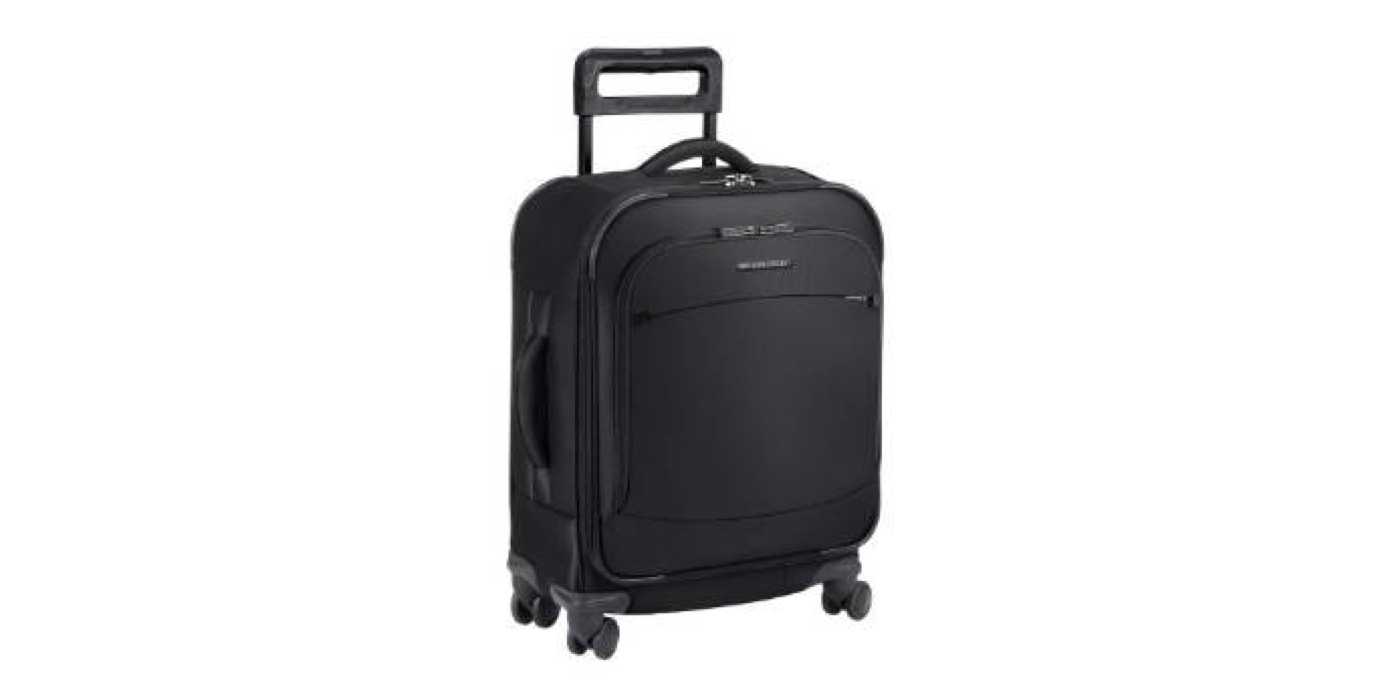
I love this bag for a few reasons.
First, the construction is sturdy. The handle doesn’t feel like it’s going to snap off, and the wheels are still rolling true after about 40 flights.
Second, it has exactly the right amount of storage for what I travel with. The pockets inside fit my two toiletry bags perfectly, and the front pockets are good for cables that don’t need to go in my small bag. There’s also a skinny pocket between the handle supports on the back that’s perfect for a sunglasses case.
Finally, it has a separator that clips together so I can put socks, underwear, and shoes at the bottom, strap ‘em down, then put my shirts and pants on top. Or, after a few days, my dirty clothes and shoes at the bottom and the clean stuff on top.
Nowadays, rolling my bag next to me with one hand, backpack set nicely on top, coffee in my free hand, I don’t feel like a sellout. I feel like a man who will arrive at his destination clean and ready to go, rather than disheveled and soaked in sweat.
2. A Small Bag to Put Under the Seat
I’ve never been a huge fan of backpacks. Even the big traveler’s backpack I used to travel with before I got the Briggs & Riley was always carried as a duffel with the straps zipped away.
Instead, I’ve always leaned toward the shoulder bag.2 It felt more grown-up against the schoolboy look of a backpack.
But my bag is fairly heavy when it’s loaded with my computer, chargers, and miscellaneous electronics I need or want to have with me. And after carrying around a messenger bag for a good number of years, I ended up with a noticeable imbalance between my shoulders.3
Deep tissue massages hurt like hell, so I made the decision to get over my aversion to backpacks. In the beginning of 2014 I switched to using a Pacsafe Venture Safe 25L GII Backpack, and I haven’t once regretted the decision. I even (kind of) feel cool wearing it.
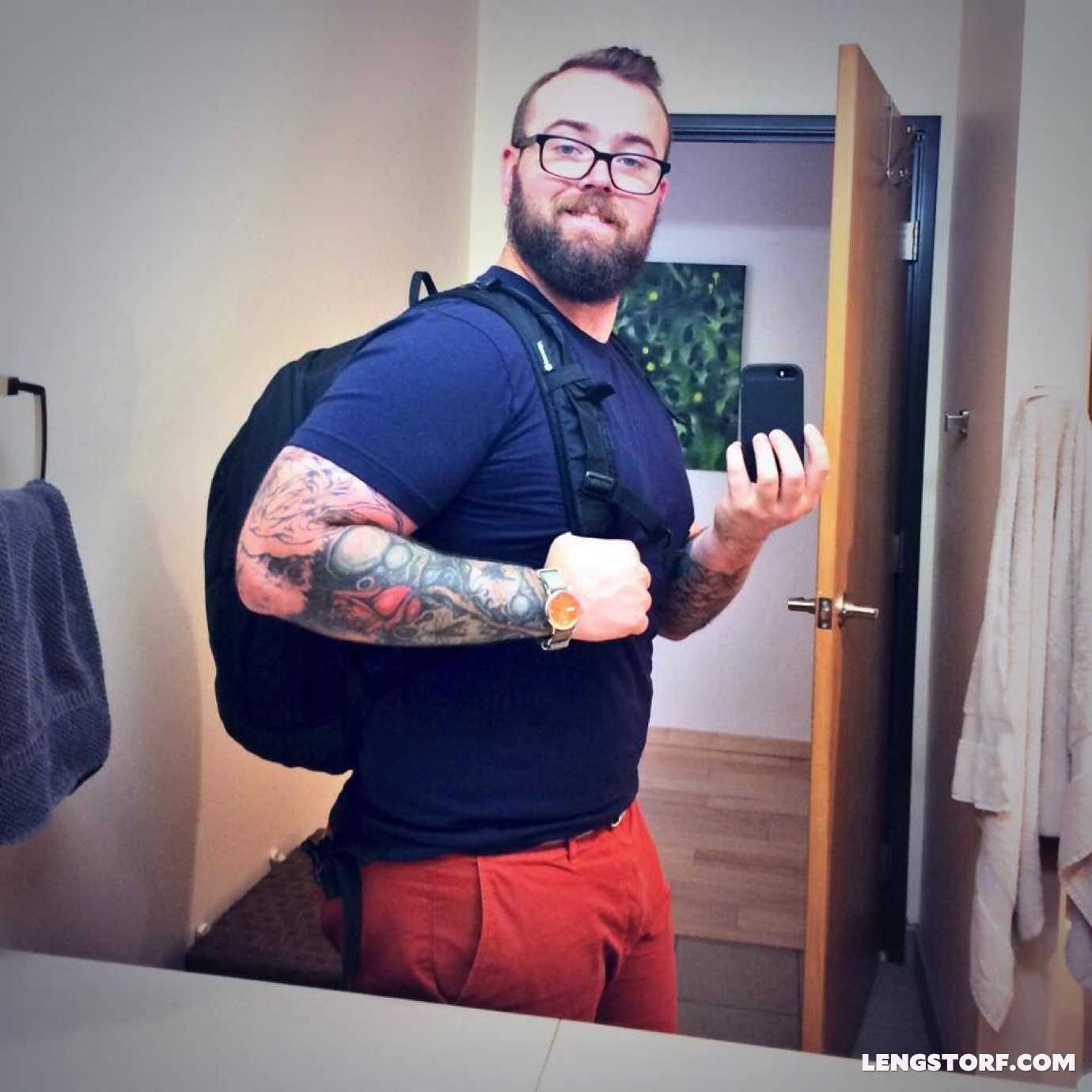
This is a backpack specifically designed for travel, and while some of its features strike me as paranoid — slash-proof straps and locking closures so you can strap it down to a chair, for example — others seem pretty damn smart.
The one that I really like is the RFID-blocking passport pocket in the front. It’s big enough for me to fit both my passport and wallet inside, and it adds a little peace of mind in an age where stealing someone’s identity is as simple as joining an open wifi network or carrying an RFID reader in your bag.
There’s a laptop sleeve inside the big zippered section, and an additional pocket next to the RFID pocket in the smaller front zippered section. I’m able to fit my laptop, a Bluetooth speaker, all my charging cables, my passport and wallet, headphones, gum, a neck pillow, a hat — and there’s still plenty of room to throw in a change of clothes and a towel.
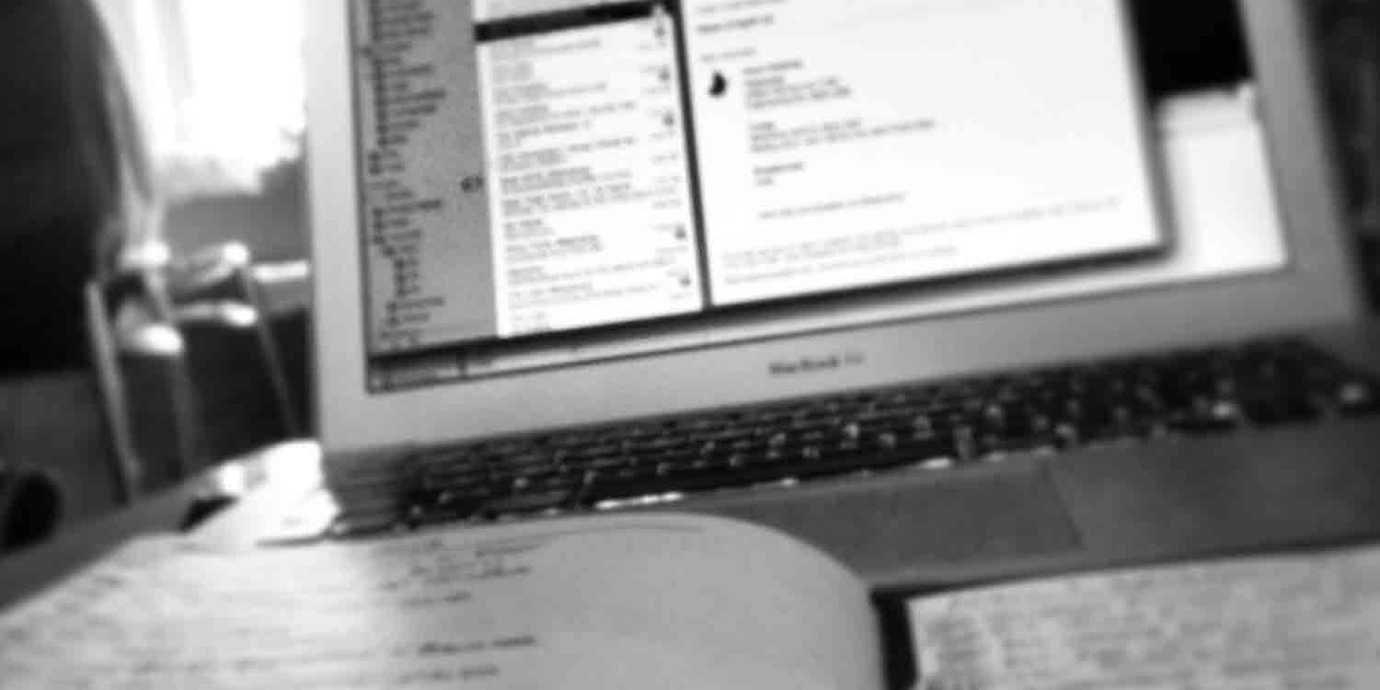
Part II — Assemble Essential Working Gear
Even on trips that I might call “vacations”, I still end up doing a little bit of work. I really enjoy what I do for a living, so it’s nice to have a full day of exploring and playing, then spend part of the evening with a drink getting something productive done.
For that reason, I never travel without my essentials for getting work done while traveling.
3. Laptop Computer
Everything I do requires a computer, so I always have one available. Currently I’m using a 15” MacBook Pro.
I’ve previously worked on a 17” MacBook Pro, but I found it to be way too big for use on an airplane. I had an 11” MacBook Air for a long time, but the work I do in Photoshop was a little too taxing and it started to drag on me.
If I were to purchase a new computer right now, it would probably be a 13” MacBook Pro, upgraded as far as it can go with RAM and processing power. That’s small enough to use on a cramped airplane tray table, and it still provides plenty of screen real estate for working (especially with an external display).
4. Headphones
In some circumstances, I really like to sit and listen to the world around me. A coffee shop can be great for focus,4 and the sound of the ocean makes even the most tedious tasks feel a lot less like work.
Most times, though, throwing on headphones and a good working playlist on Spotify is the best way for me to keep my productivity really high so I can get things done and shut down so I can eat my way across Europe.
I’ve never been big on over-the-ear headphones because they’re just too bulky for my taste. I know they sound better, but to me the trade-off in sound doesn’t justify the size.
For a long time I used sound-isolating in-ear headphones — basically earplugs with holes in the middle where music is piped through — but I ultimately settled on using the plain old Apple headphones for a few reasons.
First, the sound is fine to my ears. I’m not an audiophile, and I’m typically only wearing headphones in a space where there’s a shitload of ambient noise, so the subtleties and nuances in the music won’t make it through to my ears anyways.
Second, I like the microphone and volume control that’s built into the cord. It’s as good as any Bluetooth headset or bulky wired headset I’ve found, and I don’t feel awkward wearing them in public.5
These are definitely a simple item, but I miss few things more than headphones if I forget them.
5. Tablet
I’ve heard of people switching to tablets and ditching laptops altogether, but that’s definitely not me. I still need an actual computer to get real work done, at least for the time being.

However, a tablet is a great way to add a sort of Swiss Army Gadget to your travel kit. I use an iPad for a few purposes, each of which is very different from the others (and extremely useful to me).
1. A tablet is a book. I actually prefer the Kindle’s display since it’s more like paper, but to avoid carrying two gadgets I’m perfectly happy to read on my iPad.
2. A tablet is a TV. Occasionally, I’ll set up my iPad to play something off Netflix, Hulu, or Amazon. This is helpful for days when I feel an uncontrollable urge to watch the Countdown episode of The IT Crowd.
3. A tablet is good for killing time. When I only have a few minutes, or if I’m just not in the mood to read, I’ll use my tablet to play sudoku or some other casual game.
6. Extra Monitor
I know, I know. Packing an extra monitor sounds unnecessary. But hear me out.
I love having a little extra screen real estate to work with; having messages and utility apps on a secondary screen helps me quickly scan what’s happening without taking my focus away from whatever I’m working on.
To that end, I picked up the ASUS MB168B+ monitor. It’s incredibly light, and I can fit it in the laptop pocket of my backpack along with my laptop, so there’s virtually no added bulk.
It’s USB-powered, which means it’s really easy to use. However, that also means the screen’s brightness and sharpness aren’t on the level of bulkier monitors. I wouldn’t recommend this monitor as a place for doing graphics work, but it’s fantastic for messaging, the command line, or other text-based apps that I need to scan as I work.
7. Unlocked Smartphone
These days, a smartphone is more or less essential to being alive. We’ve come to rely on our phones to tell us everything from what we’re doing today to who loves us to where we should eat tonight.
Traveling abroad is no different, except it helps if your phone is “unlocked”. The difference, if you’re not familiar with the term, is that an unlocked phone allows you to replace the SIM card in the phone, which means you can change it over to different providers and networks as you wander.
The primary benefit of this is that you can continue to have a phone no matter where you are in the world. Things like maps and phone calls continue to work — you just need to get a prepaid SIM card.6
When no reliable wifi is available, the phone can be used as a personal wifi connection.7
I also use my phone to take photos. I’m not a photographer, so carrying around a “good” camera is a waste of luggage space in my case.
8. Bluetooth Speaker
As a general rule, I have music playing at all times. Whether I’m having a shower dance party, putting on some folky tunes while I relax, or blasting ridiculous hip hop for no reason whatsoever, there’s always something on.
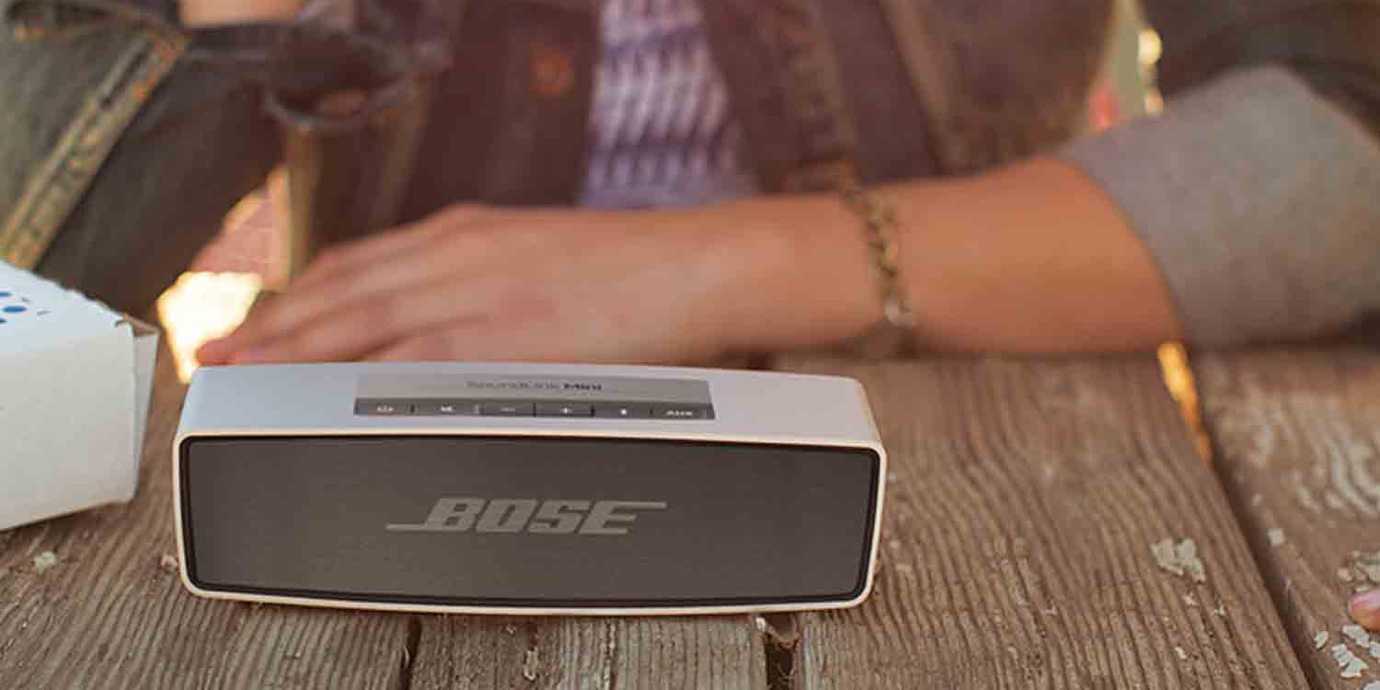
For the times when I don’t need to keep my music to myself, I keep a Bluetooth speaker with me. I’ve used several, but the one I like the most is the Bose Mini Soundlink portable speaker. It’s got solid battery life, the sound is awesome, and it’s not too big to stuff in the bottom of my small bag.
Part III — Pack the Right Toiletries
Toiletries are definitely a given, and some of the things I bring with me — toothbrush, comb, deodorant, fingernail clippers, etc. — aren’t worth explaining.8 However, a few of my toiletries might seem unnecessary or strange at first blush; I assure you, they’re not.
9. Your own shampoo and conditioner
Almost anywhere you would stay while traveling will supply shampoo, and most will also have some kind of conditioner. Or at least the 2-in-1 combo stuff.
I used it for a long time. Why worry about packing extra stuff, especially when airport security only allows you a thimbleful of anything liquid?
What I found was that bringing my own shampoo and conditioner helped me avoid the feeling of being temporary. Using the same products that I use at home makes me feel like I’m just having a normal day, which leads me to better productivity and less of the “fuck it I’m on vacation” attitude.
It’s worth the investment to get a set of travel containers and fill them with your shampoo and conditioner.
10. Your own soap
I hate hotel soap. It’s too unpredictable.
Sometimes it’s really fancy, moisturizing, made-from-upcycled-angel-wings spa soap, and other times it’s more or less plastic that bubbles when it gets wet. And — this is the worst — sometimes it’s in a dispenser stuck to the inside of the shower like the hand soap in a public restroom.

On top of this, I’m kind of a hippie about my soap; I like the all-natural soap that’s full of tree bark or lava rocks or whatever so I can feel it getting the dirt off me when I scrub.
Having my own soap also helps with routine in the same way as bringing my own shampoo and conditioner, but in this case it’s more about knowing that I won’t be lathering up with pink soap from a push pump every morning.
11. Baby powder (or Gold Bond)
When I travel, I walk a lot, and the climate usually isn’t as temperate as the Pacific Northwest. A light dusting of baby powder in a few key regions helps ensure I don’t end up feeling gross and smelly as the day wears on.
I use the Gold Bond medicated stuff because… well, honestly because it feels fucking awesome.9
Part IV — Know What Clothes to Pack
No one would call me fashionable. However, I do care how I’m dressed, and I’m not willing to give up what little fashion sense I have when I travel.
While traveling, I want to find a balance between wearing nothing but Exofficio gear and packing an extra suitcase just for accessories and stylish hats.
12. The Uniform
The biggest improvement I’ve made in my style to date has been to choose “my uniform”.
This isn’t a concept I came up with; people far more stylish than I, like Tom Ford and Michael Kors, have adopted a uniform as a way of remaining fashionable and keeping things simple.10
My uniform is extremely simple: a short-sleeve or 3/4 sleeve tee and either jeans or chinos.11 I like this because it’s casual enough to wear anywhere, but nice enough I can wear it at a speaking gig or in most fancy restaurants. It can be dressed up with a blazer or cardigan, or dressed down with casual shoes.
Having a uniform allows me to pack lighter: all of the items I pack match each other, so four t-shirts and two pairs of pants creates eight different outfits.
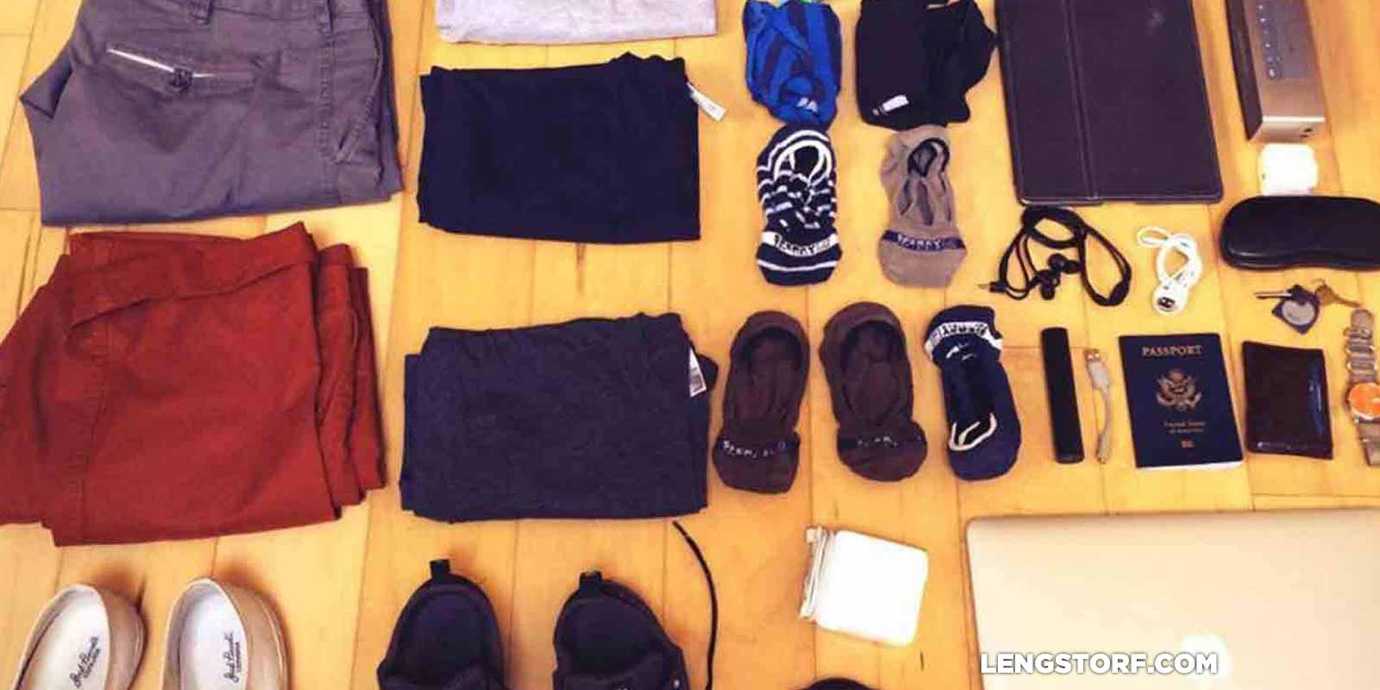
I buy my t-shirts from American Apparel, and I really like the fit of both AG Jeans and Bonobos straight leg chinos. You’ll rarely find me wearing anything else.
13. The Right Shoes
Packing tons of shoes is a great way to end up with a checked bag. To avoid this, it’s important to make sure you have versatile shoes that can serve a number of purposes.
When I travel, I usually bring Nike Frees or Jack Purcell Converse All-Stars, Ariat boots, Merrell shoes with Vibram soles, and flip flops.
The Nikes or Converse serve as my general-purpose shoes. They work with a “going out” outfit, or with shorts, or with pretty much anything else I might be wearing.
The boots are incredibly comfortable, so I like to wear them for walking. With jeans, they actually look passable as “nice shoes” in case the sneakers are too casual. And if the weather isn’t ideal, they’re good for the rain.
The Merrells are great for hiking or active stuff. I like the barefoot shoes — the kind that don’t have individual toes. If you don’t like that, you could swap these out for sturdier hiking shoes or something more suited to the kind of outdoor play you’re into.
Flip flops are always good to have around in case of a beach run, a pool, or a shared shower.12
14. 4–6 days’ Worth of Socks and Underwear
No matter how long I’m gone for, I rarely pack for more than 6 days. Usually I’ll plan my longer stays in a place that has a washer and dryer, or I’ll go to a laundromat. As a last resort I’ll pay for the hotel’s laundry service.
I love Sperry’s no-show socks for my sneakers, and I prefer SmartWool socks for the boots. And — possible overshare, here — I wear Diesel boxer-briefs.13
Disclosure
Some of the links on this page are affiliate links. That means that if you purchase something I’ve recommended here, the company sends me a little bit of money. The cost doesn’t change for you (and in some cases, it’s cheaper), so this is a win-win. If you’d rather not use the affiliate links, a Google search will turn up any item by name.
IMPORTANT: I actually use every product and company I’m recommending here. No one paid for my recommendations. If you have any questions or want to call pics-or-it-didn’t-happen, just contact me.
This is totally a women’s bag. I didn’t realize it at the time, but I really appreciated a lot of the “female-specific” features, such as the shoe compartment in the bottom. I’m not sure why this is considered a women-only bag, actually.
A.K.A. the messenger bag, man-bag, or murse. Fun fact: when I was younger, these weren’t in style yet (in Montana, at least), so I taught myself to sew and made a pattern for messenger bags. I made three in total. The first one was horrible: corduroy and some kind of cheap velvet-ish liner — it looked like the inside of a club I imagine Ron Jeremy owns. The second was a somewhat passable effort made of black duck-cloth. The last one was actually awesome (I thought): I took tan, white, and black, and sewed them into a striped pattern. It had internal pockets with zippers and everything. I felt like goddamn Martha Stewart.
Imagine a freeze-frame from the Thriller music video.
Apparently this is backed by science. That helps me justify the fact that I spent 10+ hours a day in the Whitefish City Brew between 2004 and 2006 while I was first building my freelance business.
I really do try not to judge people who wear Bluetooth headsets in public. Despite my best efforts, though, I’m still guilty of playing the occasional game of “Bluetooth or Crazy?” when I see people walking down the street talking to themselves.
You can also work something out with your current provider in some cases. The costs and coverage vary, and some plans are way better than others — just know that an unlocked phone isn’t the only option.
This can get a little spendy, though, so make sure your current plan/SIM card provides enough data at a good price before you start tethering.
If you really want to hear why I prefer spearmint toothpaste over peppermint, I’m happy to rant about it on Twitter.
Also my junk feels like an extra in an Outkast video.
As an added benefit, a uniform also prevents you from trend hopping or misguided attempts to start fashion trends with giant, lumpy hats.
I also bring shorts when I’m going somewhere hot.
I wouldn’t recommend wearing them otherwise, though, because they really suck to walk in, and some places want closed-toe shoes.
The really colorful ones. Are you picturing it? What about now? You’re welcome.
What to do next.
If you’re like me, the idea of traveling permanently while making a living probably seems like a dream — but you don’t think you can pull it off.
I felt that way right up until I actually boarded a flight to leave the United States back in 2014 — and now I can’t believe I didn’t start living this life sooner.
The secret to a life on your terms — work where and when you want, living anywhere in the world — is remote work. And there’s good news: it’s easier than ever before to join the ranks of location-independent workers around the world.
I want to help you. The best remote workers all have a set of non-technical skills, and I’ve put together a free 6-point checklist to help you master them — and ultimately master your time and ability to work anywhere in the world.